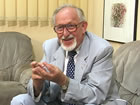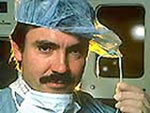![]()
<< To Homepage >>
<<Archives>>
March-April 2006 Archives:
April 1, 2006 "Fantastic Voyage": Truth is
Stranger When I produced live case demonstration courses for cardiologists, I always used that clip to introduce a laser angioplasty case -- it was eerie to watch Edmund O'Brien and Raquel Welch laser-blasting a blood clot, and then (slow dissolve to 20 years later) watch Drs. Richard Myler and David Cumberland open up a blocked leg artery with a eerie green glowing laser catheter -- on live TV. Zap! Buzz! I always wondered if the idea for "Fantastic Voyage" came from reality. The movie was made in 1966 and the trailer (which you MUST see -- courtesy of the NY Times -- free registration required) states it was two years in the making. So the film was conceived in 1964 -- the year in which Dr. Charles Dotter performed the very first angioplasty. He not only invented the concept and coined the term, but he made his own 16mm movie about it.
The U.S. medical community thought similarly that Dotter's concept was the stuff of science fiction and nixed it. But Dr. Eberhart Zeitler of Germany saw its genius and began teaching courses in Dotter's technique. And just about the time that he had gathered a "new wave" of physicians around him, "Fantastic Voyage" was released. Zeitler, in his own words to me:
Yes, in 1966 it was really crazy. And also, by the way, Dr. Andreas Gruentzig attended one of Dr. Zeitler's courses, thought the idea was not crazy, but interesting. He felt it needed a refinement: a balloon -- one which he invented and a few years later did the first coronary angioplasty. And today this crazy idea is the number one treatment for coronary artery disease. Truth is stranger than fiction. « permalink » « send comment » « back to top »
Blame the Messenger: Reporting on Plavix
and Aspirin
Those pesky patients, putting their lives in danger by misinterpreting the following finely-nuanced reports that appeared nationwide only hours after the CHARISMA results were made public last Sunday.
My point here is that how could patients who have been prescribed Plavix and aspirin by their cardiologists NOT be terrified by these headlines? Especially when the widely-reprinted AP story begins:
As many doctors recommend? Good reason to stop? So is the message here that your doctor has made a terrible mistake by giving you a deadly mix of drugs and you'd better take this matter into your own hands? When I saw the news, I immediately realized the problem -- not only were the headlines inflammatory (medical pun intended) implying some type of toxic interaction between Plavix and aspirin, but the articles themselves left out a critical piece of information. The CHARISMA study was about expanding the applications for Plavix; it had nothing at all to do with the many patients who currently take these drugs as per FDA-approved indications -- patients for whom the drug combo is of proven benefit. And life-saving benefit. For years it's been known that Plavix (clopidogrel) and aspirin are essential for stent patients to take to prevent blood clotting inside a stent, called stent thrombosis, an incident which is fatal more than 1/3 of the time!! So by Monday noon I had posted our own Public Health Alert, also written a warning at our very popular Plavix and Aspirin Discussion Forum and ran a Google Ad, directing people to these pages. At least Internet searchers would get the right information: stent patients, don't stop taking your meds without talking to your doctor. As the week went on, I found no other place where this vitally important caveat for stent patients appeared. I couldn't understand how so many reporters could be at a major cardiology meeting and not be aware of these fundamental medical facts. I also saw the traffic on Angioplasty.Org increase explosively by 50%, with the number one search term being, you guessed it, "Plavix and aspirin". Finally, four days later, both the American Heart Association (AHA) and American College of Cardiology (ACC) posted a "Patient Guidance" and the above-mentioned "Health Alert" and Friday, in an Emily Litella moment, a whole slew of news reports appeared stating, "remember that thing about stopping taking Plavix and aspirin together...never mind!" For example, on March 17, the Wall Street Journal wrote: In the wake of news accounts of the study, doctors' offices were inundated with phone calls. "Patients are really misunderstanding this," said Steven E. Nissen, cardiologist at the Cleveland Clinic and president of the American College of Cardiology. "I'm really worried about losing people." Happy St. Patrick's Day! Hope we didn't lose you. * * * * * So what's to be learned from this roller-coaster? (Other than that you should always read Angioplasty.Org for the most accurate reporting.) Well, to the cardiologists who met last weekend in Atlanta, I would remind them that, while these annual meetings previously comprised mostly scholarly arcane symposia with little interest for the general public, in today's world there are probably as many business reporters, financial analysts, media buyers, venture capitalists and industry representatives at the ACC as there are cardiologists. And the media's thirst for a sexy (or death-y) headline will not go unquenched! This is a fact learned in the early days of angioplasty -- and since Angioplasty.Org's history timeline was utilized by this year's ACC i2 Interventional Summit (with our permission, of course) I feel vindicated in boring everyone with a short two-paragraph history lesson.
So, cardiologists -- when you publish reports or make speeches, you have to be aware how the retail and business press are going to spin it. And please don't blame patients for misinterpreting these reports. They only know what they read in the papers! * * * * *
« permalink » « send comment » « back to top »
Plavix and Aspirin -- Stent Patients, Don't
Stop Taking Your Meds You might try calling your cardiologist to find out why you were given such a dangerous drug combination, but most likely the line is busy because all his/her other patients are calling about the same thing. (We're getting questions as well in our Forum topic on the subject.) No doubt today doctors across the country are fielding questions from patients -- and the genesis for these reports is the CHARISMA study, presented yesterday at the annual meeting of the American College of Cardiology -- or rather the relatively misleading headlines about that study (some of the articles themselves are a bit clearer, but editors tend to go for attention-grabbing headlines; I call them dreadlines.) So, first off and most important: if you have a stent, a recent angioplasty, heart attack, been diagnosed with acute coronary syndrome, etc. don't stop taking your Plavix/aspirin combo without discussing it with your doctor! What has been left out of the scores of news articles I've read this morning is that nothing in this study changes the current indications for patients with Acute Coronary Syndrome, recent heart attack or coronary intervention with balloon or stent. And more importantly, if you have had a stent placed, stopping Plavix and aspirin could be very dangerous! The combination of Plavix and aspirin has been shown in many studies to be a definite benefit to patients with confirmed vascular disease and premature withdrawal of Plavix, especially for patients with drug-eluting stents, can increase the incidence of stent thrombosis (blood clotting inside the stent). This has been the subject of other studies and a topic I have discussed before. So the bottom line: the misleading media reports about this study are confusing and could be dangerous to heart patients. For more on what the study really showed, read on. CHARISMA (Clopidogrel for High Atherothrombotic Risk and Ischemic Stabilization Management and Avoidance) was a study funded by sanofi-aventis and Bristol-Myers Squibb Company, the people who make Plavix. The study was designed to determine if clopidogrel (Plavix) and aspirin together were of benefit as a preventative therapy. The company obviously hoped that the results would be positive -- there's a lot of money to be made if the drug was shown to prevent coronary events. They were disappointed, to say the least. The patient population was made up of two groups: symptomatic patients with established atherothrombotic disease (80%) and asymptomatic patients -- those with multiple risk factors (high blood pressure, etc.) for atherothrombotic events (20%) but who had not yet experienced the symptoms of vascular disease. The results did show a little benefit (about 1%) in the symptomatic patients, but not enough to warrant prescribing the combination therapy. The surprise to researchers was that the asymptomatic group (those without actual disease) showed a higher rate of death from cardiovascular causes, from 2.2% in the aspirin only to 3.9% in the combination of aspirin plus Plavix. It is this subset of patients that has generated the headlines. One of the primary investigators for the CHARISMA study, Dr. Deepak Bhatt of the Cleveland Clinic, stated that the results mean that "dual antiplatelet therapy should not be used in patients without a history of established vascular disease. " So the CHARISMA study is very important. It cautions against prescribing Plavix (clopidogrel) as a preventative therapy, especially when simple aspirin works as well or better. But for patients who already have more advanced disease, to the point where angioplasty has been performed, the dual antiplatelet combination of aspirin and Plavix is a life-saver. |
 In
August of 1964, Dotter appeared in LIFE Magazine (they went for the
mad scientist angle) and the idea of treating arterial blockages
from the inside out was publicized for the first time. Who's to say
sci-fi author
In
August of 1964, Dotter appeared in LIFE Magazine (they went for the
mad scientist angle) and the idea of treating arterial blockages
from the inside out was publicized for the first time. Who's to say
sci-fi author  "Oh,
it was futuristic. It was futuristic! We all had the feeling
that's the way we have to go. That's fantastic! It was at the
time in which also an American movie exists in which a man
was beamed small enough that you can inject him through a carotid
artery. And this man, inside a body, looking inside of the
body
diagnostic!
"Oh,
it was futuristic. It was futuristic! We all had the feeling
that's the way we have to go. That's fantastic! It was at the
time in which also an American movie exists in which a man
was beamed small enough that you can inject him through a carotid
artery. And this man, inside a body, looking inside of the
body
diagnostic! When
Zurich-based angiologist
When
Zurich-based angiologist